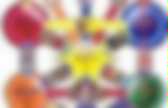

Sephirot. Sephirot (/sfɪˈroʊt/, /ˈsfɪroʊt/; Hebrew: סְפִירוֹת Səphîrôṯ), meaning emanations, are the 10 attributes/emanations in Kabbalah, through which Ein Sof (The Infinite) reveals himself and continuously creates both the physical realm and the chain of higher metaphysical realms (Seder hishtalshelus). The term is alternatively transliterated into English as Sefirot/Sefiroth, singular Sephirah/Sefirah etc. Alternative configurations of the sephirot are given by different schools in the historical development of Kabbalah, with each articulating different spiritual aspects. The tradition of enumerating 10 is stated in the Sefer Yetzirah, "Ten sephirot of nothingness, ten and not nine, ten and not eleven".
As altogether 11 sephirot are listed across the different schemes, two (Keter and Daat) are seen[by whom?] As unconscious and conscious manifestations of the same principle, conserving the ten categories[citation needed]. Ten Sephirot[edit] Listings[edit] Description[by whom?] [edit] Notes[edit] Another view of the Heavens - Zodiac Age and the Ten Sefiroth. Emphasis Mine: Another view of the Heavens is the following: Ephesians 4:9 (Now that he ascended, what is it but that he also descended first into the lower parts of the earth? 4:10 He that descended is the same also that ascended up far above all heavens, that he might fill all things.) Greek katoteros, kat-o’-ter’-os; comp. from Gr. kato, kat’-o, downwards, beneath, bottom, down, under, thus meaning inferior (locally, of Hades): -- lower. Also as seen in Chapter Six under John 8:23, "And he (Jesus) said unto them, You are from beneath (below); I am from above: ye are of this world; I am not of this world.
" The clarification of the earthly states as the lower parts of the earth is still up for research. So lets look at the diagrams of these heavens. To return to the Names of God regarding the four worlds. Now to refer to the symbolism of the sevens, notice that if one totals up the four aspects of the sevens, respecting the fact that there are only six in Araboth. Pythagorean tetractys. Donmeh West - The Mystery of the Middle Column. ByReb Yakov Leib HaKohain, Founder & Spiritual Director DONMEH WEST In many of my lectures, I refer to the "Three Columns" or "Pillars" of the Ten Sefiroth -- Left, Right and Middle -- as they are described in the Zohar and other works of Jewish Kabbalah: One of the mysteries of the Center Column that I have already pointed out several times (and which seems to have been picked up by other "Kabbalists", incidentally) is that the sum of the numerical values of the four Sefiroth of the Center Column -- Keter (1), Tiferet (6), Yesod (9) and Malkuth (10) -- is 26, which is exactly the Gematria (or numerical sum) of the four Hebrew letters forming the Tetragrammaton, Yahweh: <------ Yahweh But another mystery, revealed to us more recently, deals with the Kabbalistic permutations of the original, untranslated Hebrew names of the four Sefiroth of the Center Column -- Keter, Tiferet, Yesod and Malkuth -- as shown below: Keter = Tiferet = Yesod = Malkuth = or "Kitim" with a Gematria of 470:
Sefer Yetzirah. 10. Work of the Chariot Translations Sefer Yetzirah "The Letters of Our Father Abraham" The Book of Formation (Sefer Yetzirah) attracts heated debate about its authorship and date of origination. Many scholars attribute a medieval or Hasmonean date to the book. It is not in the scope of the present work to delineate the varied opinions that attribute a medieval date to the book's inception. The references to the "Book of Abraham" in the Qu'ran (see Surahs 87:19 and 53:37) may allude to this book or some version of it. The Work of the Chariot Trust (WC) version was made using all six known textural sources. The Book of Formation is the first mystical manual on, and possibly the source text for, the original Hebrew alphabet. Like the three innermost core texts of the Book of Splendor, the Book of Formation stands out within primary qabalistic literature for the depth, terseness, and obscurity of its language, and for its wealth of mystical allusions.
Chapter One 2. 4. 5. 6. 7. 8. 9. 10. 11. The Golden Age of Peace and the Tree of Life.